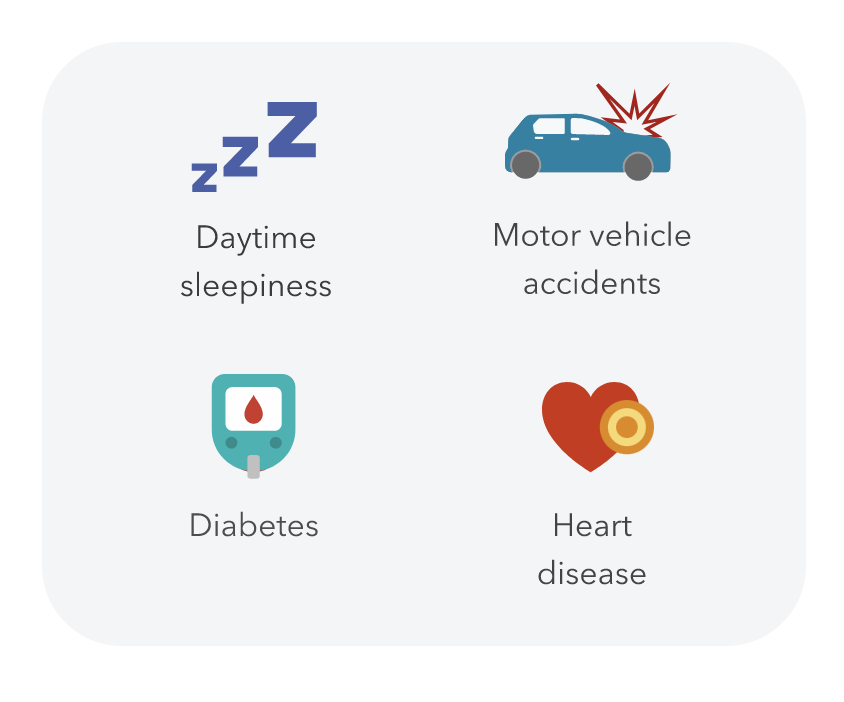Is Obstructive Sleep Apnea Genetic?Explore Obstructive Sleep Apnea and what your DNA can tell you
What is obstructive sleep apnea?
Obstructive sleep apnea (OSA) is a condition where breathing stops and starts repeatedly during sleep. It occurs when tissues in the throat relax during sleep and block the airway.
Diagnosis of OSA is often defined as someone experiencing impaired breathing at least five times per hour of sleep along with other symptoms like daytime sleepiness.
How obstructive sleep apnea can impact your health
People with OSA often experience interrupted sleep, excessive daytime sleepiness, and difficulty concentrating. Because of this, those with OSA are at higher risk of motor vehicle accidents and should be especially careful when driving. Additionally, OSA is strongly associated with type 2 diabetes and an increased risk for high blood pressure and heart disease.

A healthy lifestyle can reduce symptoms.
Experts agree that healthy lifestyle habits can help reduce the severity of obstructive sleep apnea symptoms. Tips for managing OSA include maintaining a healthy weight, eating a healthy diet, exercising regularly, limiting alcohol consumption, and avoiding sleeping on your back.
Other factors that may cause an increased likelihood of obstructive sleep apnea
It is estimated that around one in five adults have at least mild symptoms of obstructive sleep apnea. Genetics, weight, and lifestyle are some factors that contribute to developing OSA. Other factors that can increase a person’s chances of developing OSA include age, family history, sex, and the shape and size of the bones and tissues in the head and throat.
The condition becomes more common as people get older. More males than females are diagnosed with OSA but the chances of developing OSA in females increase after menopause.
Are your genetics related to obstructive sleep apnea?
23andMe can provide information about your genetic likelihood of developing obstructive sleep apnea. The 23andMe Obstructive Sleep Apnea report (Powered by 23andMe Research) can help you understand your chances of developing OSA. This report is part of the 23andMe+ Premium membership. 23andMe+ Premium includes everything in our Health + Ancestry Service plus new premium reports and features throughout the year.

23andMe+ Premium
Please note:
- The Obstructive Sleep Apnea report (Powered by 23andMe Research) does not diagnose obstructive sleep apnea and should not be used to make medical decisions.
- The report was developed by 23andMe scientists using data and insights gathered from thousands of customers who consent to participate in our research. Reports based on 23andMe research provide an estimate of your likelihood of developing a condition based on your genetics and other factors. This report does not account for lifestyle or family history.
- The report does not account for every possible genetic variant that could affect your likelihood of developing obstructive sleep apnea.
References
American Sleep Apnea Association. “Sleep Apnea – American Sleep Apnea Association (ASAA).” Retrieved July 28, 2020, from https://www.sleepapnea.org.
Epstein LJ et al. (2009). “Clinical guideline for the evaluation, management and long-term care of obstructive sleep apnea in adults.” J Clin Sleep Med. 5(3):263-76.
Mayo Clinic. “Sleep apnea.” Retrieved July 14, 2020, from https://www.mayoclinic.org/diseases-conditions/sleep-apnea/symptoms-causes/syc-20377631.
Qaseem A et al. (2013). “Management of obstructive sleep apnea in adults: A clinical practice guideline from the American College of Physicians.” Ann Intern Med. 159(7):471-83.
Qaseem A et al. (2014). “Diagnosis of obstructive sleep apnea in adults: a clinical practice guideline from the American College of Physicians.” Ann Intern Med. 161(3):210-20.
Semelka M et al. (2016). “Diagnosis and Treatment of Obstructive Sleep Apnea in Adults.” Am Fam Physician. 94(5):355-60.
Young T et al. (2002). “Epidemiology of obstructive sleep apnea: a population health perspective.” Am J Respir Crit Care Med. 165(9):1217-39.